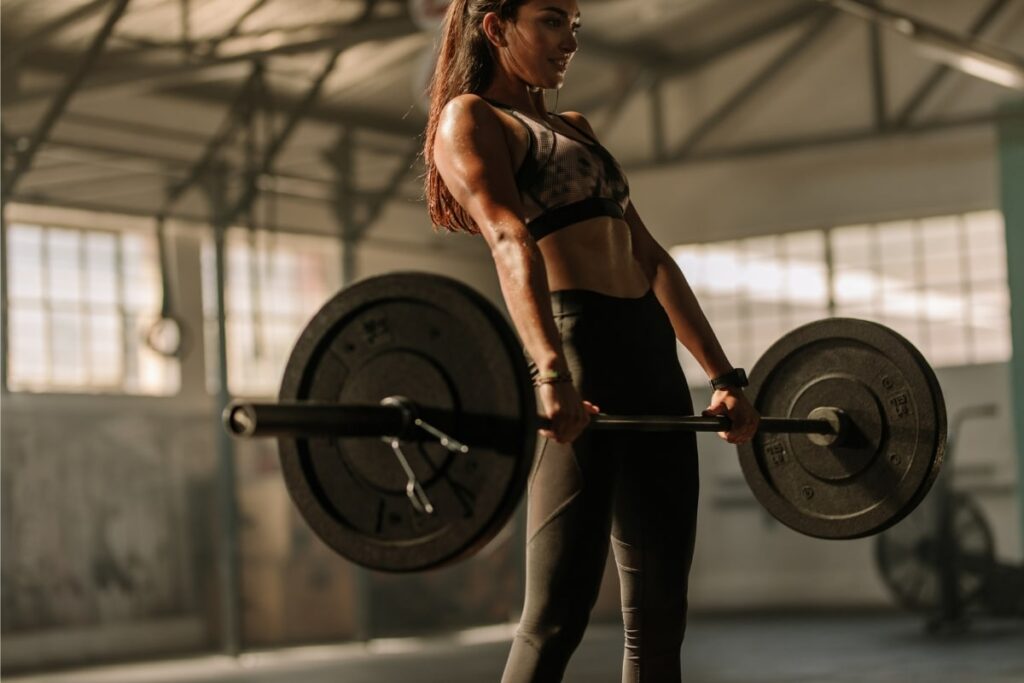The deadlift workout works out multiple muscle groups in your upper and lower body. It is an excellent compound exercise for building strength and can be performed with various weights. Building strength is the foundation of any muscle-building workout program. It would help if you had the strength to do the volume necessary to build muscle.
Whether you’re a gym rat or just getting started with strength training, the deadlift is an important exercise to master. It’s one of the most effective exercises for building strength and power in your body. The key to perfecting the deadlift is understanding the proper volume, sets, repetitions, and rest time necessary to ensure maximum results.
This article will cover the muscles worked by the deadlift, how to perform the deadlift, the volume needed to build muscle, and variations of the deadlift.
Muscles Worked by a Deadlift Workout
The deadlift works out multiple muscle groups in your upper and lower body, including your quads, hamstrings, glutes, back, and core. Additionally, it is an excellent exercise for grip strength. The following are the primary muscles worked by the deadlift:
Quadriceps
The quadriceps are the large muscles on the front of your thighs. They are responsible for knee extension, which is needed to perform the deadlift.
Hamstrings
The hamstrings are the large muscles on the back of your thighs. They are responsible for knee flexion and hip extension; both needed to perform the deadlift.
Glutes
The glutes are the large muscles on your buttocks. They are responsible for hip extension, which is needed to perform the deadlift.
Back
The back muscles work to stabilize your spine during the deadlift. More specifically, the deadlift is a lift similar to the row; it works the lats, rhomboids, and traps.
Core
The core muscles work to stabilize your trunk during the deadlift.
Grip Strength: Grip strength is essential for performing the deadlift as you will be holding onto a weight throughout the entire exercise.
How to Perform a Deadlift Workout
There are many different ways to perform a deadlift workout, but we will focus on two of the most common variations – the barbell and the dumbbell deadlift.
Barbell Deadlift
Start by positioning a barbell in front of your feet with your feet shoulder-width apart. Bend at your hips and knees and grip the barbell with an overhand grip (palms facing down). Lift your chest and squeeze your shoulder blades together. Keeping your back straight, drive through your heels and stand up with the barbell in front of your thighs. Reverse the motion and lower the barbell back to starting position. That’s one rep.
Dumbbell Deadlift
Start by standing with a dumbbell in each hand with your feet shoulder-width apart. Bend at your hips and knees and lower your torso until it’s parallel to the floor (or as low as you can go without rounding your back). Then, keeping your back straight, drive through your heels and stand up with dumbbells in front of your thighs. Reverse the motion and lower the dumbbells back to starting position. That’s one rep.
Volume for a Deadlift Workout
The weight you should lift during a deadlift workout will depend on your fitness level and goals. If you’re a beginner or just getting back into shape after some time off, start with lighter weights and gradually increase them as you become stronger. You want to challenge yourself but not exceed your limits – otherwise, you risk injury or overtraining. Generally speaking, aim to lift around 60-80% of your one rep max (1RM) during each set.
Sets and Repetitions
In terms of sets and repetitions for deadlifts, this will also depend on your fitness level and goals. If you’re looking to build muscle mass, then aim for 3-6 sets of 8-12 reps per set. If you’re more focused on strength gains, do 4-6 sets of 1-5 reps per set. Remember that if you go lower than five reps per set, it can be difficult to keep proper form, so make sure not to sacrifice technique to hit those numbers.
Rest Time
Rest between sets plays a vital role in deadlifting properly and effectively. For muscle gain purposes, aim for 1-2 minutes between sets, while for a strong focus on 2-3 minutes rest between sets – this will give your muscles enough time to recover before lifting again at total capacity. Additionally, ensure you drink plenty of water throughout your workout session, as hydration is critical for any successful workout program!
Variations of a Deadlift Workout to Perform
But did you know that there are several different variations of the deadlift? So let’s break down the different types of deadlifts and explain which one is right for you.
Barbell Deadlift
The barbell deadlift workout is the most common type of deadlift. It is performed with a barbell loaded with weight plates. To complete the barbell deadlift, stand with your feet hip-width apart and grasp the barbell with an overhand grip, your hands shoulder-width apart. Then, keeping your back straight, push your hips back and lower the barbell to the floor. Then, drive your heels to the ground and lift the barbell back to the starting position.
Trap Bar Deadlift
The trap bar deadlift is a variation of the deadlift that uses a hexagonal-shaped bar. The benefit of using a trap bar is that it allows you to maintain a more upright posture during the lift, which takes stress off your lower back.
To perform the trap bar deadlift, stand in the center of the trap bar and bend down to grasp the handles. Then, keeping your back straight, drive your heels into the ground and lift the bar until you stand upright.
Sumo Deadlift
The sumo deadlift workout is a variation of the deadlift that uses a wide stance and places your hands inside your legs. This variation is often used by powerlifters because it allows them to lift heavier weights. To perform the sumo deadlift, start by placing your feet wider than shoulder-width apart and turning your toes out slightly. Next, bend down and grasp the barbell with an overhand grip, your hands inside your legs. Then, keeping your back straight, drive your heels into the ground and lift the barbell until you are standing upright.
Romanian Deadlift
The Romanian deadlift is a variation of the deadlift that targets your hamstrings more than any other muscle group. Hold a dumbbell in each hand with an overhand grip to perform the Romanian deadlift. First, stand with your feet hip-width apart and keep your knees slightly bent throughout the exercise. Next, bend at your hips and lower the dumbbells toward your shins until you feel a stretch in your hamstrings. Then, drive through your heels and raise yourself to the starting position.
Dumbbell Deadlift
The dumbbell deadlift is a variation of the deadlift that uses two dumbbells instead of a barbell or one dumbbell. This variation is excellent for people who want to increase their range of motion or have difficulty grasping a barbell. To perform the dumbbell deadlift, start by placing a dumbbell on each side of your feet. Next, bend down and grab the dumbbells with an overhand grip. Keep your back straight as you lift the dumbbells until you stand upright.
Kettlebell Deadlifts
The kettlebell deadlift is an exercise that uses a kettlebell instead of a barbell or dumbbell. To perform the kettlebell deadlift, start with the kettlebell in front of you, between your feet.
Staggered Stance Deadlifts
The staggered stance deadlift is a variation that uses two different foot placements. To perform the staggered stance deadlift, start with one arm in front of you and one leg behind you. Then perform a barbell or dumbbell staggered stance deadlift.
Final Thought on a Deadlift Workout
The deadlift is one of the essential exercises that you can do in the gym. Not only does it work your entire posterior chain, but it also strengthens your grip and builds core stability. And, perhaps most importantly, it is an excellent measure of strength.
Also, a deadlift workout is an excellent exercise for building power in your entire body. Still, they must be done correctly with the proper volume, sets, repetitions, and rest times incorporated into each session. The exact parameters may vary depending on individual needs; however, following these guidelines will help ensure maximum results without risking injury or overtraining!
If you love bodybuilding, share this article on Facebook or Twitter so that others can learn more about building muscle.




